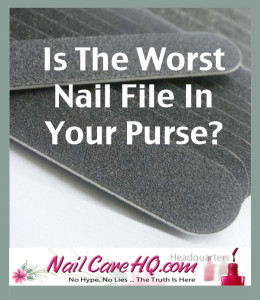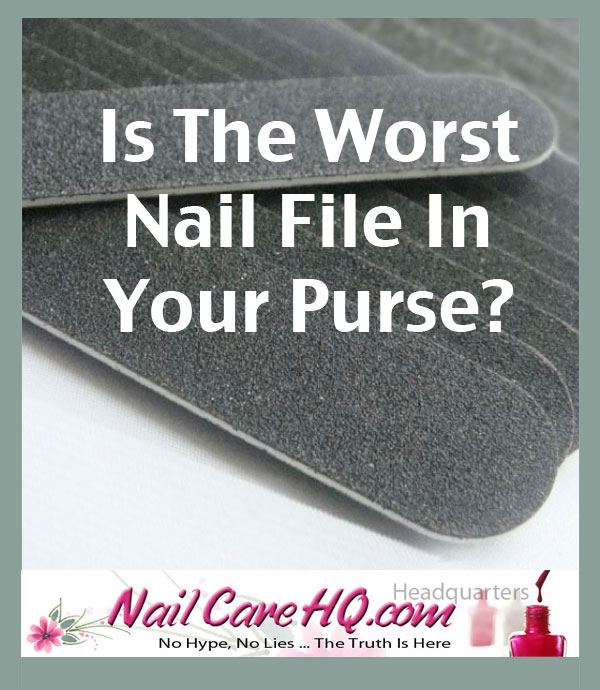 Nail Files – Is The Worst Nail File In Your Purse?
Nail Files – Is The Worst Nail File In Your Purse?
Do you know how to chose a nail file for proper nail care?
Or are there just too many choices and the “grits” make no sense?
By the end of this post you’ll understand which type of file is best for you and your nails.
Guest Author: Kayla Shevonne
![]()
Different Types of Nail Files
The most crucial factor to know regarding files may be the term “grit.” Much like sandpaper, a nail file’s surface is known as its “grit,” with the the amount of abrasive grain particles that can fit into a square inch.
The grit number informs you whether the file is fine or coarse, and therefore how rough or gentle it will likely be to your nails. The lower the number, the harsher the file is going to be—and also the more damage it may cause towards your natural nail.
So a 400 grit file has far more particles than an 80 grit file.
The Nitty Gritty
Here is a quick rundown of a few grit levels:
NOT Safe For Natural Nails
80 grit: This is extremely coarse and should NEVER be used on natural fingernails. Some could use this on artificial nails but even so, it’s still a tad too rough.
100 grit: This as well, is a rough file. 100 grit can safely be utilized on artificial nails only.
Safe For Natural Nails
180 grit: This is actually the lowest grit appropriate for natural nails. If your nails are damaged or vulnerable to damage, you might like to choose a finer grit file. I use the 180 grit on my own nails to file them down.
240 grit: This is a softer grit file and is frequently used to obtain a smooth finish or buffing artificial nails.
500 grit: A file with this grit is extremely soft and usually only used to polish the surface of acrylic or gel nails. This is a great nail file for one last swipe against the edge of your natural nails to remove any burrs caused by stronger filing with the 180 grit file.
Crystal file: A crystal file is made of either glass (less expensive) or crystal (more expensive). The positives are ultra-fine textured grit permanently etched in the glass. Since the surface is 100% nonporous glass, it can be disinfected and sanitized.
The negatives are that the file should be dampened before using, which isn’t always convenient…and… it breaks if dropped!
The Worst Nail File!
The Metal File: This kind of file is fairly common because they are available in nearly every manicure set.
However, if you use this type of file, please STOP! Get rid of it right now.
Different files probably take up more room inside your purse—but please—replace the metal file with one that is kinder to your nails.
Metal files are EXTREMELY hard on natural nails and can only cause more damage than what you’re going to use it for.
In Conclusion
The very best file to use on natural nails is 180/240. It’s sufficiently strong and will remove length, but not so strong that it shreds your nails. It very helpful to look for files that have the grit number printed right on them so you can easily grab the right one.

What is the purpose of dampening the glass/crystal file?
That is an excellent question Jenna. Apparently, it files more efficiently and smoothly than when used dry. I’m not quite sure why this is since I don’t have one to personally test.
I do know that my mother loves them. As a matter of fact, now that I think about it, she borrowed the one I did purchase and it broke on her tile when it slipped off the coffee table! LOL. ~Ana
This is great info! I recently bought a glass nail file (after hearing about how good they’re supposed to be) but had NO idea it was supposed to be used damp!
when you say metal files, does this include diamond and sapphire coated as well?
Shirl, if the diamond and sapphire coated nail files have a really high grit level, which means that it will feel almost smooth, then they would be fine. Most of these files have a coarse texture which you can feel with your fingers. This would be too coarse for natural nails. ~Ana
the 1’s we buy have a slight feel to the rougher side, and are almost smooth on the other side…..
how would I know if my nails are damaged, and if they can be repaired? the majority of them feel smooth and have no splits etc. I only have a few problems with my nails:- they can get soft and bend easy, but I do have my hands in water a lot… my ring finger on my left hand has big ridges on it. and the nail of my right ring finger has a regrown nail from when I was in my early teens, as it was ripped out by a machine. this is shaped different, and splits in layers at the tip, but it’s been like that since it grew back !?!?!
Shirl, you know when your nails are damaged when they don’t look right or behave like your other nails. Water is the worst thing for your nails and they can soak up one third their weight in water! Over time, with repeated exposure to water, the water molecules push the l00 layers of your nail keratin apart like a book that’s gotten wet.
I explain in much more detail in my How to Treat Brittle and Peeling Nails article. http://www.NailCareHQ.com/StrengthenBrittleNails
The best thing you can do is hydrate them with a jojoba based nail oil like Pure Nail Oil™ https://www.nailcarehq.com/shop/pure-nail-oil-starter-kit/, and then keep them completely wrapped in several layers of polish to prevent water absorption.
I have all the instructions in my How to Prevent Chipped Nails In the Shower article. https://www.nailcarehq.com/chipped-nail-polish-from-the-shower
Like you, I have a nail that was severely damaged in my youth when it was smashed in a car door. Since the matrix was damaged as well, the nail that continues to grow in has a huge ridge that likes to split down the middle at the tip. That nail will never change from how it is being created now.
The only thing you can do is keep trimming it short to before the split or repairing it with a silk wrap reinforcement. You don’t have to cover your entire nail, just the splitting area with a small piece of silk wrap and nail glue. My favorite is IBD Brush on Gel Resin. It’s a thick nail glue that is nothing like the current soak off gel polishes. It’s available at Sally’s Beauty. Hope that helps! ~Ana
thank you, I will defo give the treatments a go.
I have purchased some of the jojoba oil, and I started to use it last night. I also bought some nail files that are 180/240 and I’ve been using them too. I also purchased some nail buffers, but I’m still waiting for them to arrive.
So far I’ve smoothed my nails of using an old nail buffer (it still kind of works) and I’ve been applying the oil. I can’t stop feeling them, as they are so smooth with a slight shine – lol. I just need to get the glue now…..
thanks again for the info, it is very much appreciated ~ Shirl
You said GRIT is the most crucial factor, but do not say what GRIT a crystal file is. Is it finer than 500? Or do different crystal files have different grits? I’m looking for something to keep the EDGES of my nails smooth (for playing guitar)
Paul, my apologies for the delay in getting back to you. Crystal files are not rated with a grit number, but based on all the other grit files I have, they seem to be between 400-600 grit. ~Ana
Ana, where can I get the bliss kiss nail file!
Ciara, we plan on making the Bliss Kiss™ crystal nail file available in the next few weeks. If you’re following me on FB or IG, I’ll be posting when they are available. ~Ana
yours is the best
Really helpful ana..thank you.